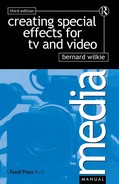Model Ships
Commensurate with the size of the tank or the area of water available, model ships should be as large as possible. It is often easier to handle and film a big model than a small one. Large ships have a better relationship with the wave scale and manoeuvre better on water. Another bonus is that it is generally easier to construct the detail on large models and, although the cost of materials is likely to be higher, the speed of work is often quicker.
Sub-frame
Waves generated on the studio tank can cause the model ship to bob up and down in an uncharacteristic fashion. To eliminate this it is possible to construct a sub-frame to which the hull can be attached by rods. The frame can be manipulated from below, imparting a lifelike roll-and-pitch movement to the model above.
Anchored in this fasion the model cannot of course travel forward, but if water is made to flow past the hull, the effect is the same as forward motion of the boat.
Wakes and bow waves
To improve the illusion of forward motion it is usual to provide the model with a false wake and false bow-waves. White liquid stored in tanks in the hull or fed by submerged pipes can be made to flow from waterline holes at the stern of the ship, the resultant trail appearing most effective. Similarly, small waves on either side of the bows can be contrived by fixing small backward facing tubes just below the water. These effects look best when the ship is actually being propelled (or pulled by an underwater line) on a large tank or on open water.
Outdoors
Ships on outdoor lakes or rivers or even the sea can be driven by battery-powered screws. It is seldom practical to have these connected to underwater power lines, so radio control should be employed to switch the motor and to control the rudder. It is often found that extended keels help to damp down unwanted rolling movements.
Submarine shots
‘Underwater’ shots of submarines can be filmed in the dry if the models are hung on wires in front of a green background. Careful lighting can create the illusion that the vessel is actually under water, particularly if a water ripple effect is projected on the upper part of the backing and onto the submarine itself.
Another method is to use the model against front or rear scenic projection of an underwater setting.

1. Storm sequences
Model ships appearing in storm sequences are best anchored to a fixed base which can be manipulated to impart a realistic pitch and roll action.
2. Towing precautions
Models being towed should have their tow lines weighted to keep them below water level. Extended keels reduce unnatural motion caused by the towing action. Take care that the wake from the towing vessel does not appear in the shot
